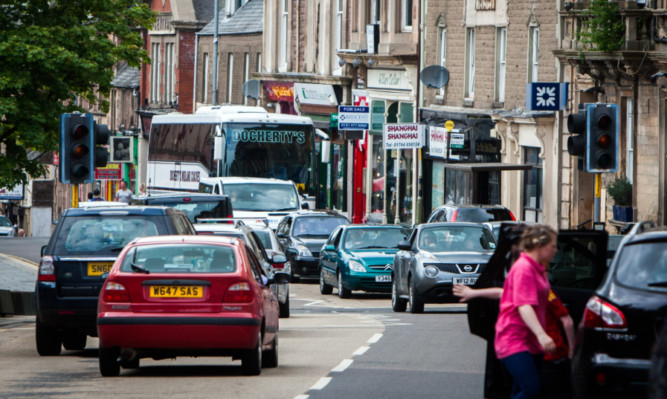Councillors have admitted that there is “no easy solution” to air pollution problems in Crieff.
A series of measures has been suggested to reduce harmful emissions and improve the town’s air quality and, during a meeting of Perth and Kinross Council’s environment committee, members discussed a range of ways to overcome the problem.
Studies carried out over a period of five years resulted in West High Street, East High Street, High Street and Comrie Street being declared an Air Quality Management Area (AQMA), after toxic gases reached harmful levels.
At the beginning of the consultation in 2005, nitrogen dioxide levels in Crieff were measured at around 37 microgrammes per cubic metre, well below the 40 mic standard.
By 2010, however, parts of the town had risen dramatically to 44 mic per cubic metre, significantly above the acceptable level.
Environment convener Alan Grant said: “Given the measurements taken over the last few months, it is clear the situation is one we need to address.
“In Crieff, the difficulties are very much focused on the High Street.”
A report before the councillors blamed the rise on high levels of traffic, saying this was further exacerbated by the “street canyon” effect caused by narrow streets and high buildings on either side of the A85 trunk road through the town.
Councillor Murray Lyle had his own theory, however.
He said: “There are some 20 takeaway shops located on the High Street that cause traffic congestion. There is an issue over traffic management there as well.
“We have to get other organisations to cooperate with us to try to deal with this problem. If we don’t do this, then there will be nothing else we can do.”
This opinion was shared by Councillor Callum Gillies, who also blamed motorists sitting with their engines idling, and he was echoed by local member Rhona Brock.
She said: “I also want to highlight the issues regarding parking. I come through Crieff every day and the yellow lines along the High Street are barely visible.
“Crieff does have a lot of issues there and I’d like to address them.
“I would welcome some sort of manager in the High Street to keep traffic moving, so we don’t have people parking their vehicles, and have traffic flowing easily through the town.”
The notion of a bypass around Crieff was mentioned in passing.
However, Councillor Mac Roberts questioned what the impact of such a move would have on the town.
He added: “This would be a very obvious solution, but it’s very difficult to say what the results would be.”
Meanwhile, Councillor Anne Younger who represents the Strathearn ward, welcomed the report and said it was a sign that the significant problem in Crieff was being recognised at last.
Ms Younger added that she hoped the figures could be used to start planning ahead to alleviate the issue. The council is set to launch a major community consultation on the extent of the Crieff AQMA.
The community councils, parentcouncils and Crieff and Upper Strathearn Partnership will be consulted, alongside Transport Scotland, Sepa and other key stakeholders. The public consultation will take place over the summer of 2013.
